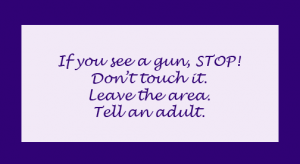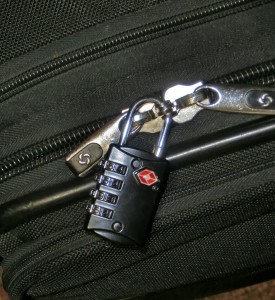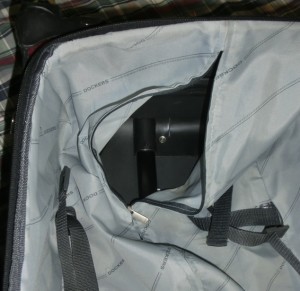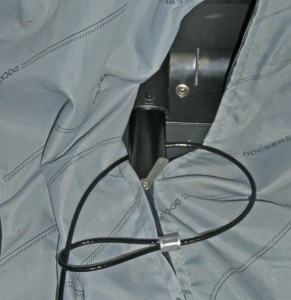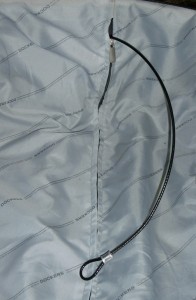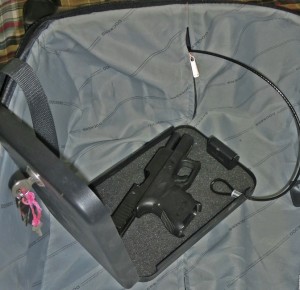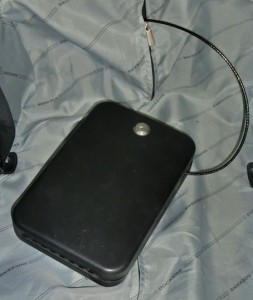Injuries from loaded guns usually arise from longstanding bad habits with unloaded ones.
Here’s a case in point, a severe hand injury posted by user hunterrwill on Instagram.[ref] Definitely owe a “thanks” to someone for this link. But I’m not sure who I need to thank because I truly can’t figure out how I ended up seeing it. It just showed up in my active tabs one afternoon apparently out of the clear blue sky. If you know whom I might thank for it, please drop me a note in the comments.[/ref] (Link possibly NSFW for gory pictures. You can see the same pictures in the screenshot below the jump at the bottom of this post.)
Before digging into the meat of what we need to talk about here, let me first take care of an important human issue. I’ve never met the person who posted these pictures, and know absolutely nothing about him other than what he says about himself in this one post. But even though that’s all I know about him, there’s one thing I can say about him, personally: he’s brave. He did something foolish and painful, and then instead of hiding it or not telling anyone about it, he put his story out there so that the rest of us could learn from what he did. That takes guts. Full kudos to him for that.
Since this ugly event cost him so much and since he put it out there so that others can learn, the least we can do is learn from it. So let’s get started.
What happened?
Here’s how the shooter describes the painful incident:
I had just made it home from work and was gonna oil my gun and put my new grip pin and trigger pins in the gun. It was loaded with gold dot +Ps and I dropped the mag racked the slide and was pulling the trigger to take the slide off and had my palm in front of the muzzle to pull the tabs down like I would with any unloaded glock. I shot through my hand and out my wrist.
I did everything correctly as far as mechanically unloading the gun but the bullet didn’t eject. It’s been a good learning experience for me, even though it sucks to have to learn the hard way to triple check, it’s worth it in the end.[ref] I added paragraphing to make his post easier to read, but did not otherwise alter his words.[/ref]
When the gun fired, this shooter won his Bullet Surprise, finding a round (the hard way) inside a gun after he had unloaded it. Most noisy mistakes of this nature happen when someone does things in the wrong order or when they skip a step entirely as they’re unloading the gun — that is, they rack the slide and then drop the magazine, or they forget to drop the magazine at all. But in this case, the shooter did go through the motions in the right order: mag first, then slide.[ref] This does not mean that he “did everything correctly” when he unloaded the gun. It just means he went through those particular steps in the correct order.[/ref]
To understand how the round could have stayed in the chamber even though the shooter removed the magazine and racked the slide, please read the Bullet Surprise article. But to understand what happened in the human behavior sense, we need to dig a little deeper.
When we jump into human behavior questions, it’s easy to think that we’re making things too personal — like we’re just bashing or hating on this poor guy who was brave enough to share his story. That’s not the point. What happened to him could happen to any one of us, if the same factors come together for us. The point here is to stop those factors from coming together for anyone else. That’s it and that’s all.
In the comments section of this and similar stories from others, people often point out the one, big, obvious lesson: when you unload a gun, you should always check to see that the gun is really unloaded before you do anything else with it. And that’s important, as we’ll see below.
But it’s not the only lesson we can take away from this one. And it’s far from the most important.
Why did this happen?
Look again at the shooter’s description of what happened. He reported that he:
- Dropped the magazine,
- racked the slide,
- put his left hand in front of the muzzle, and
- pulled the trigger.
Wait, what? He put his left hand in front of the muzzle? Why in the world would he do that?
The answer boils down to one word: habit. In the shooter’s own words, he put his palm in front of the muzzle “like I would with any unloaded Glock.” Pointing the gun at himself during the disassembly process was a longstanding, built-in habit. It was something this shooter did all the time, every time he disassembled his Glock.
Don’t do it this way
To show how this bad habit happens — and how to prevent it happening to you — I talked a friend of mine into modeling some unsafe behavior in front of the camera.
The gun is a Glock 19. To make the gun safe for these pictures, we took it apart and removed its barrel. Then we replaced the real barrel with a bright yellow Training Barrel from Blade Tech. This simple piece of plastic makes it impossible to load or fire any type of ammunition from the gun.
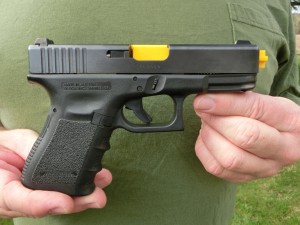
To safely show unsafe behavior, we used a Training Barrel to disable a Glock 19. With this bright yellow piece of solid plastic replacing the original barrel, the gun cannot hold or fire a live round.
Many people apparently believe that the correct way to disassemble a Glock for cleaning looks something like this:
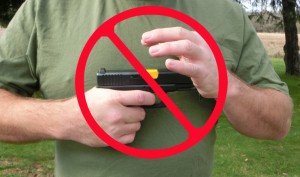
“Push the gun into the palm of your left hand while you press the trigger.”
Uh, no.
The rest of that incorrect process looks something like this:

“Wrap your left hand around the muzzle while you pull down on the takedown levers with your finger on the trigger.”
And then this:
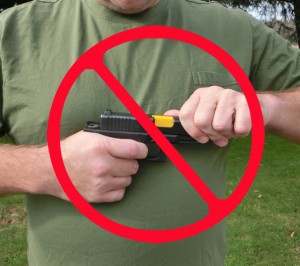
“Smother the front end of the gun with your left hand, being sure that your pinkie and ring finger will be in the line of fire, as you remove the slide.”
Again, no. That’s not safe behavior — and yet it is behavior that we see, over and over again, from people who really should know better. (Links NSFW because they all have gory pictures.)
Cue the line of cranky old guys saying that this pattern of injury is the Glock’s fault, because “you have to press the trigger in order to disassemble the gun.” It’s true that you do have to press the trigger in order to take this brand of gun apart for cleaning. But there is nothing, in any manual of arms for this gun or any other gun anywhere, that forces you to put your hand in front of the muzzle.
Putting one hand in front of the muzzle every time you disassemble the gun is not the result of a moment’s inattention. It’s a longstanding, dangerous habit. That habit is not the gun’s fault. It’s just what naturally happens when someone doesn’t know a better way to get the gun apart.
But there is a better way.
Better way
Here’s how to take the Glock down without building a bad habit of pointing the gun at yourself during the process.
First, choose a safe direction. Because the light was beautiful outside and because green grass makes a nice picture, we chose to use the yard (which has a safe backstop) for our demonstration. Inside, your safe direction could be a box full of old phone books, or a bucket full of sand, or a fully packed bookcase, or a solid brick fireplace with something in front of it to discourage bouncebacks. You could even purchase a purpose-made Safe Direction pad. If you are on the ground level of your home, you might choose to use the floor as your safe direction. Just be sure to angle the gun away from you, at about a 45-degree angle, rather than pointing straight down where a bullet could bounce back up at you.
With the gun pointed in your safe direction, unload the gun:
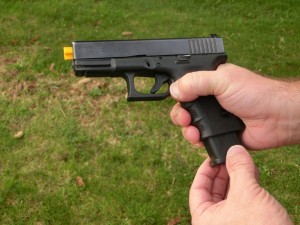
Remove the magazine.
Rack the slide, hard. Then lock it open.
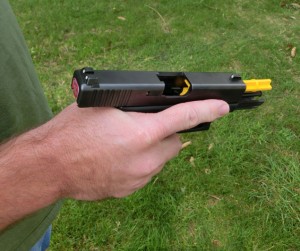
Lock the slide open.
With the action locked open, double-check that the gun is really empty. First look into the chamber, then feel the chamber. (To answer a common question: when you stick a finger into the chamber, you’re feeling for the hole. If you can’t feel the hole, there may be something important blocking it, such as a round of ammunition.)
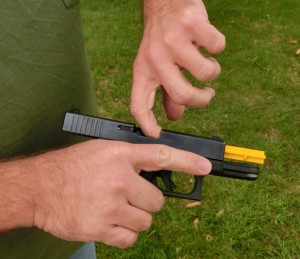
Check the chamber by sight, then by feel.
Now double-check that the magazine really did leave the gun. Again, first look at the magazine well, then feel it to be sure it’s really empty.
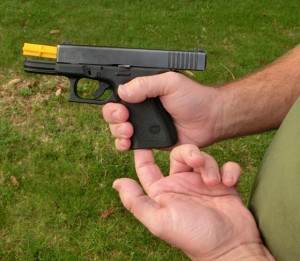
Check the magazine well first by sight, then by feel.
Disassemble
Now we’re certain the gun is unloaded, but we will still continue to treat it with the same cautious respect we’d give it if we knew for sure that it was loaded.[ref] In other words, we continue to follow Rule One.[/ref]
With the gun pointed at your safe backstop, press the trigger.
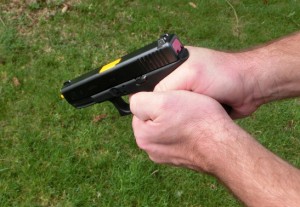
Point the gun in a safe direction and press the trigger.
Here’s the tricky part. I suspect a lot of people push at the slide from the front end because they don’t know this marvelous little trick called a “gunsmith’s hold.” It’s really easy. You only have to budge the slide a smidgen anyway, so:
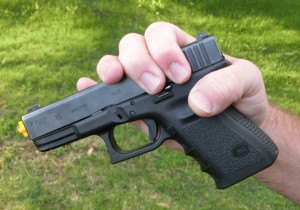
Wrap your hand over the top rear of the gun.
Basically, all you do is hold the gun from the back, with your fingers wrapped over the top of the gun, then squeeze your hand together until the slide moves. As I said, it doesn’t take much.
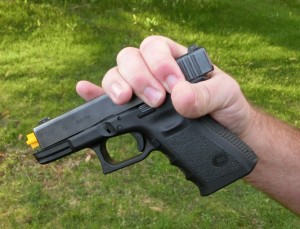
Squeeze your fingers together until the slide moves just slightly to the rear.
Note that the gun is still pointed in its safe direction.
While you’re holding the slide back slightly with your gunsmith’s hold, bring your left hand up from underneath the gun so that you can reach the takedown levers. Pull down on those levers until you feel the slide release.
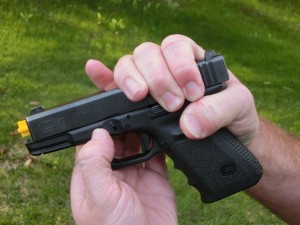
With the gun still pointed in a safe direction, pull down on the takedown levers until you feel the slide release.
The biggest cause of failure at this point would be pulling the slide too far back, so that the trigger resets before you’ve depressed the levers. If that happens, don’t despair. Just rack the slide and start the process over with a fresh trigger press.
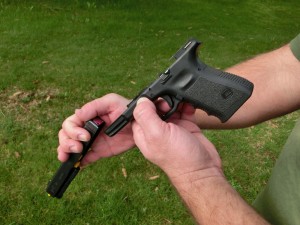
Remove the slide from the frame. Ready to clean!
Lessons
This post has already gotten far too long, but I wanted to leave you with one last thought. Bad habits kill people. They really do. When I see injuries like these, it really hurts my heart because we know they happen to real people every day. They cost thousands of dollars in medical bills, thousands of hours of lost wages and (sometimes) lost jobs. They lead to permanent disfigurement, ugly scars and lost function. The pain and stress that accompany them result in broken relationships, broken marriages, broken people.
It doesn’t have to be this way.
Build good habits. Then — even with unloaded guns! — protect your good habits, so that your good habits can protect you.
Below the jump: graphic pictures of what a longstanding bad habit did to one man’s hand.
Continue reading →
